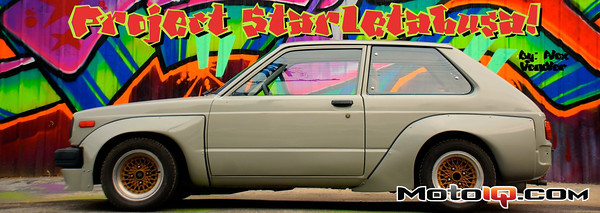,
Now that the body of the car has been chopped up and readied for the body kit let's take a look at the flares themselves and how they are held onto the car. When I got the car the flares were held on with a combination of nuts and bolts, self tapping screws, and a couple of drywall screws thrown into the mix. There were several sets of holes in the body from different attempts at mounting the flares. It was a mess. I decided to stick with the bolt on system for the flares as I wanted to be able to remove them easily for repair work if anything gets damaged in the future. Just screwing into sheetmetal was not going to be good enough and it is really difficult to get behind the rear quarters of the car if I were to use nuts and bolts.

Instead I found these nifty 6mm weld on threaded inserts and I just tack welded them to the body wherever a screw hole was needed. Now one can install and remove a flare in just a couple of minutes and never have to worry about stripping out sheet metal screws or being forced to give a reach around to hard to access nuts. Handy! As you can see in the next picture when combined with a button head allen screw the result is passably professional looking.

Now that all the mounting issues were handled it was time to figure out how to actually get the flares to look decent. Being fiberglass they are a bit flexible and after being bolted to the car very incorrectly for decades they had become severely deformed. Fixing this issue took more time than the rest of the body work on the car combined. Since the flares are relatively pliant it's a challenge to fill and sand them as they will change shape once on the car. I ended up bolting them into place and doing all the fiberglass repair work with them attached in order to ensure that they would fit properly once the layers of resin and filler cured. Fiberglass succumbs to cracks and other surface imperfections as it ages, so much of the original gel coat was sanded off, filler was used to fix all the problems and then several coats of polyester hi-build primer as a last step. Hi-build primer is like sprayable bondo and is probably the most useful bodywork product ever invented. It will fill up to 80 grit sand scratches and sands off really smoothly for a paint ready surface.
 |
|
|
The picture and caption here give you an idea of the basic supplies used in the course of paint and body work. Depending on the scope of the job there may be much more to buy but these items are the basics and then some. The order of operations for the work done on this car went a bit like this: First off strip any suspect filler using an aggressive scotchbrite disc. “Suspect” means cracked, bulging, blistering, or just not well finished, areas of filler. This car had suspect repairs on all four corners and on the driver's side door. Once that filler was ground off I did what I could to hammer out the deformed metal. Fortunately there were not too many really bad dents in the car just a lot of smaller dings. Next, after a careful cleaning with a solvent, layers of filler are added. On the fiberglass parts I used fiber re-enforced filler and on the steel parts just regular filler. I cut and shaped this filler with 100 grit sandpaper on a D.A. sander and with a block by hand. Several thin layers of filler will be needed to get the panels straight. One often overlooked tool in the body work quiver is the filler applying squeegee. They need to be clean, straight, and flexible, in order to apply the filler in thin layers. Really work to avoid putting on too much filler in one application as it wastes a lot of sanding time. Once the main filler was applied and shaped, I switched to an ultra light filling putty. This stuff is very thin and spreads out easily over large areas to repair shallow flaws and waves. I covered the fiberglass parts completely with a skim coat of this putty. It is meant to be used in very thin layers and it must be applied with a very straight squeegee. This skim coat was sanded with 220 sandpaper and mostly by hand. Once that was done I shot repaired areas with a layer of high-build primer, sanding that off with a hand block and repeated that process until the panels were looking straight. After all that work the car was starting to look pretty good. Much better than when I started. I guess this went to my head, along with many different types of fumes, and I proceeded to make a pretty big error.



